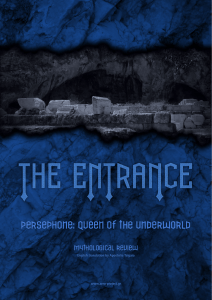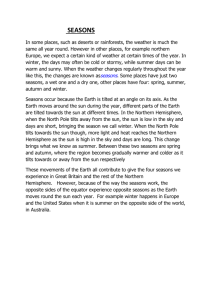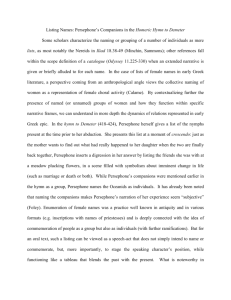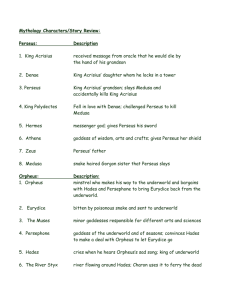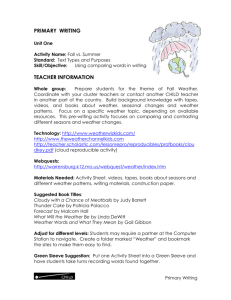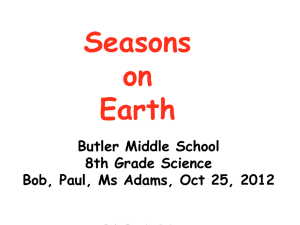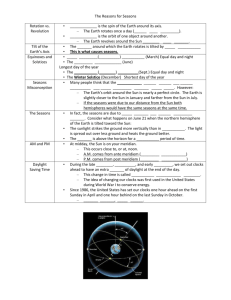Why Does Earth Have Seasons?
advertisement
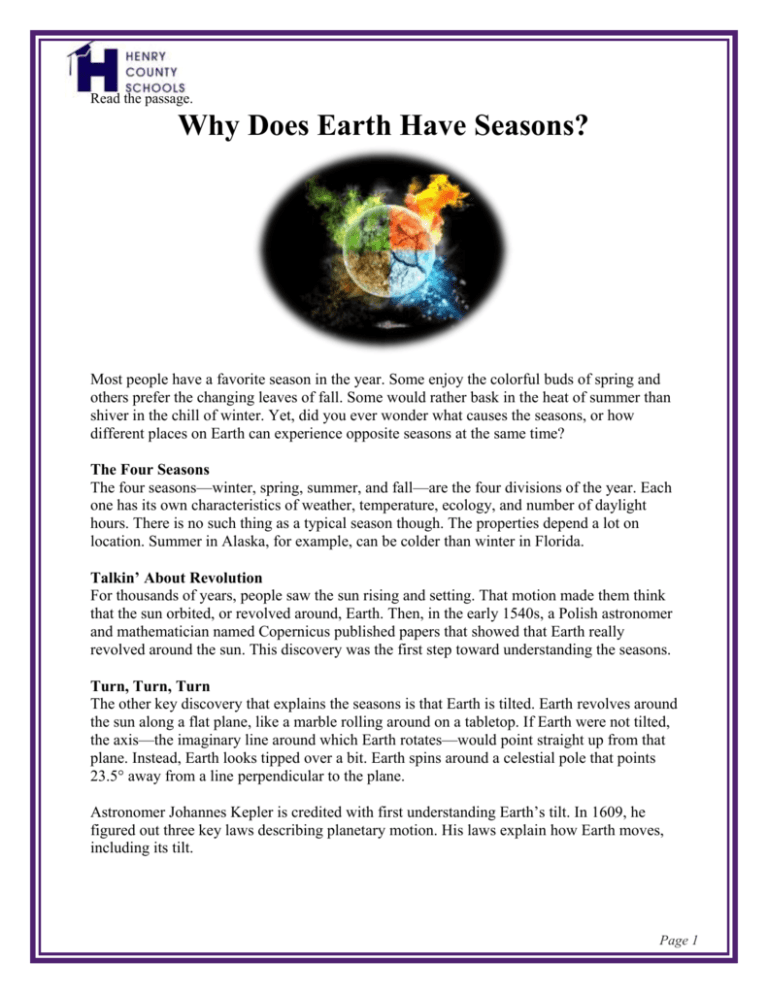
Read the passage. Why Does Earth Have Seasons? Most people have a favorite season in the year. Some enjoy the colorful buds of spring and others prefer the changing leaves of fall. Some would rather bask in the heat of summer than shiver in the chill of winter. Yet, did you ever wonder what causes the seasons, or how different places on Earth can experience opposite seasons at the same time? The Four Seasons The four seasons—winter, spring, summer, and fall—are the four divisions of the year. Each one has its own characteristics of weather, temperature, ecology, and number of daylight hours. There is no such thing as a typical season though. The properties depend a lot on location. Summer in Alaska, for example, can be colder than winter in Florida. Talkin’ About Revolution For thousands of years, people saw the sun rising and setting. That motion made them think that the sun orbited, or revolved around, Earth. Then, in the early 1540s, a Polish astronomer and mathematician named Copernicus published papers that showed that Earth really revolved around the sun. This discovery was the first step toward understanding the seasons. Turn, Turn, Turn The other key discovery that explains the seasons is that Earth is tilted. Earth revolves around the sun along a flat plane, like a marble rolling around on a tabletop. If Earth were not tilted, the axis—the imaginary line around which Earth rotates—would point straight up from that plane. Instead, Earth looks tipped over a bit. Earth spins around a celestial pole that points 23.5° away from a line perpendicular to the plane. Astronomer Johannes Kepler is credited with first understanding Earth’s tilt. In 1609, he figured out three key laws describing planetary motion. His laws explain how Earth moves, including its tilt. Page 1 Seasons in the Sun The seasons occur because of Earth’s tilt as it rotates and its motion as it revolves around the sun. On the part of Earth that tilts toward the sun, it is summer. In those places, sunlight travels more directly toward the surface, like a flashlight shining from directly overhead. Days are longer. More heat reaches the surface, so temperatures are higher. Winter occurs on the side that is tilted away from the sun. Sunlight beams onto Earth’s surface at a flatter angle. More rays scatter and don’t reach the surface. Days are shorter. These factors mean that less energy from the sun reaches Earth’s surface in winter. Therefore, it is cooler. Question One: This question has two parts. First, answer Part A. Then, answer Part B. Page 2 Part A Reread the section “Talkin’ About Revolution.” Which choice best describes how the paragraph is organized? A. chronological order B. main idea and detail C. problem and solution D. part to whole Part B Which words from the section help the reader identify that structure? Select all that apply. A. For thousands of years B. rising and setting C. the sun orbited, or revolved around, Earth D. Then, in the early 1540s E. This discovery F. first step Question Two: Read this paragraph and all parts of the question before responding. Winter occurs on the side that is tilted away from the sun. Sunlight beams onto Earth’s surface at a flatter angle. More rays scatter and don’t reach the surface. Days are shorter. These factors mean that less energy from the sun reaches Earth’s surface in winter. Therefore, it is cooler. Part A What is this paragraph mainly about? A. why Earth has a tilt B. why winter is different from summer C. why winter days are shorter D. why it is cooler in winter Part B Explain how the other sentences in this paragraph develop the main idea. Sample Constructed Response (Question Three) What is the author’s purpose for writing this passage? Use details from the text to support your response. Persephone and the Seasons Page 3 adapted from The Iliad The story is a retelling of a Greek myth about how the four seasons came to be. This myth was most likely first told in the seventh century BCE and reflects beliefs about seasons from that time period. Demeter, goddess of the harvest, was distraught. Her beloved daughter, who knew all the flowers by name, and whose laughter once rang through the valleys like the twinkle of distant bells, had disappeared. It had happened on a dazzlingly sunny day—back then, every day was warm, and Earth had never experienced frost, sleet, or snow. All the flowers in the world were always in full bloom, and the fruit trees were always heavy with apples, figs, and plums. Demeter’s grown daughter, Persephone, had been picking flowers in the meadow. As she pulled a lone daisy from the earth, the ground began to rumble and shake. A rift appeared, then widened, and out of it sprang a sleek, horse-drawn carriage commandeered by Hades, god of the underworld. Demeter watched in horror as her daughter was snatched from the valley and carried deep into the dark depths of the world below Earth. As Persephone disappeared, crying out for her mother, the ground sealed itself as if it had never been split. Down in the underworld, Hades immediately professed his love for Persephone, but his confession was met with silence, and then tears. Longing to see her smile, or to hear just one second of her famous laughter, he showered her with gold forged in the fires of the underworld, while begging her to be queen of his vast kingdom. But Persephone, in her sorrow, couldn’t bear to listen. She was heartsick for her mother and the bright, blooming Earth she had left behind. Nothing could grow in the depths of the underworld, whose darkness was interrupted only by lamplight and fire. With eyes hungry for color, Persephone spent entire days staring at the red and yellow flames, remembering the fields above that burst with poppies and daffodils. Despite Hades’ begging, she refused to eat, for legend told that if one ate in the underworld, one would be doomed to remain there forever. Each day more desperate to win her heart, Hades journeyed up to Earth to bring back some of the flowers that Persephone loved so much. But what he found there shocked him. There were no flowers to be seen, and no colors either. The trees had shriveled and hardened into rock; the plants were as gray as ashes. Ever since Persephone had disappeared, Demeter, in her deep depression, neglected her work of keeping the world’s greenery alive. Instead, she donned black robes and roamed the countryside in the guise of a human, moaning her sorrow to anyone who would listen. Page 4 Meanwhile, the barley fields grew as dry as the throat of a desert wanderer. The grapes, once plump and brilliantly violet, now fell from their vines each time Demeter shed a tear. Seeing the destruction, Hades called upon his brother Zeus, the all-powerful king of the gods. Since Persephone had disappeared, Zeus had watched the beautiful fields of his kingdom turn from green to brown, while the people who tended them grew hungrier and hungrier. “You must allow Persephone to return to our world,” Zeus demanded, “Demeter is miserable and our people will soon starve.” But the thought of losing Persephone was a poison arrow to Hades’ heart. “Never,” he bellowed, boarding his chariot once more and descending through the ground into his kingdom. When Hades arrived, all the ghosts of the underworld ran up to meet him. “She has eaten,” they cried, pointing to a blood-red pomegranate that Persephone had broken open, “Now she must stay forever and keep us company.” “Please,” Persephone cried, “I only ate four seeds because I was so thirsty. It was so little—I ate just what I needed to stay alive. Please let me go back to my world, if only to say goodbye to my mother.” She grasped Hades’ hand as her tearful eyes implored him to understand. And at that moment, for the first time, Hades truly understood how unhappy she would be if she had to spend all her days in the underworld. He promised that he would talk to Zeus that day. Up on Earth, Hades, Zeus, and Demeter discussed a deal: they decided that Persephone would spend half the year above ground and then return to the underworld for the other half. Everyone agreed that Demeter would be happy to have her daughter back, while the ghosts of the underworld would be grateful for Persephone’s sunny laughter in their dark and dreary home. To symbolize the four pomegranate seeds Persephone had eaten, Earth would now have four seasons, called winter, spring, summer, and fall. Persephone would spend spring and summer on Earth with her mother, as the flowers bloomed and plant life flourished. In fall, she would return to the underworld, and remain there through the winter. Though overjoyed to have her daughter back for spring and summer, Demeter grew sorrowful each fall. As she missed Persephone more and more, the leaves on the trees took on the fiery red and orange hues of the underworld’s flames before finally falling one by one. Eventually, Demeter’s sadness became so great that all the plants died for the winter, only coming back to life as she grew hopeful for Persephone’s spring return. Question Four: Read the sentence from the passage and the question that follows. Page 5 With eyes hungry for color, Persephone spent entire days staring at the red and yellow flames, remembering the fields above that burst with poppies and daffodils. What does the phrase “hungry for color” tell you about Persephone’s state of mind? A. She knows that the people on Earth have been hungry since she disappeared. B. She misses the bright surroundings of her home and is unhappy in the underworld. C. The four pomegranate seeds she ate weren’t enough to fill her. D. She likes only flowers that are yellow and orange. Question Five: Answer the following questions about both passages in this lesson. Which of these statements are true of both “Why Does Earth Have Seasons?” and “Persephone and the Seasons”? Circle all that apply. A. Both are broken into sections that contain different scientific facts. B. Both give an explanation of why the seasons occur. C. Both agree that in the beginning of the world, there were no seasons. D. Both discuss four seasons—winter, spring, summer, and fall. E. Both use similes to help readers imagine what fall looks like. F. Both give readers an idea of people’s beliefs about seasons in different time periods. G. Both discuss the sun’s role in the changing seasons. Question Six (Sample Extended Response) Compare and contrast the ways the authors of “Why Does Earth Have Seasons?” and “Persephone and the Seasons” approach the same topic. First, summarize each passage, emphasizing its purpose, genre, and main idea or theme. Then, explain how the structure and language used to describe the topic differs across the passages. Use details from both passages to support your response. Write your answer on the lines below. Page 6

